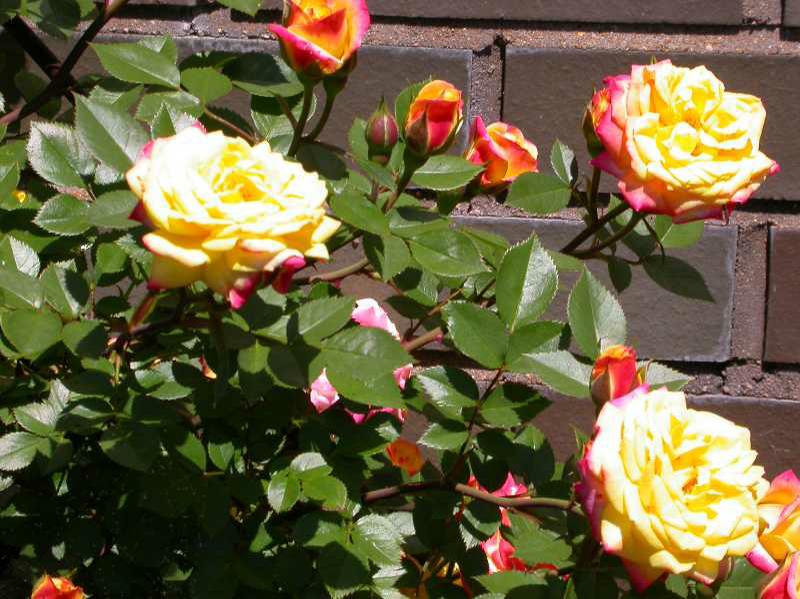Miniature Rose (Rosa ‘Savaclend’ Climbing Rainbow’s End)
Miniature Rose
Rosa is a genus of about 150 species of deciduous (occasionally evergreen) shrubs and climbers noted for their beautiful, often fragrant, single, semidouble or double flowers which are borne singly or in clusters on often prickly stems clad with 5-9 leaflets often having toothed margins.
Miniature roses look very much like shrubby, dwarf versions of floribunda or hybrid tea roses. They can be used as edging or as a groundcover. Some may be small climbers. They generally produce flowers in sprays, which can almost completely cover a plant. Most bloom several times a year.
Genus name comes from the Latin name for rose.
CLIMBING RAINBOW’S END is a climbing miniature rose that will typically grow 10-12’ at maturity. Its foliage and flowers are proportionally much smaller than those of regular size climbing roses. It was discovered as a sport of the popular minature rose R. ‘Savalife’ RAINBOW’S END. It features bicolor double roses (75” across) of bright yellow edged with red. Flowers eventually mature to orange/red and red. Blooms freely from May to frost. Dark green foliage. U.S. Plant Patent #11,257 issued February 29, 2000.

Best grown in organically rich, medium moisture, well-drained loams in full sun. Tolerates light shade, but best flowering and disease resistance generally occur in full sun. Water deeply and regularly (mornings are best). Avoid overhead watering. Good air circulation promotes vigorous and healthy growth and helps control foliar diseases. Summer mulch helps retain moisture, keeps roots cool and discourages weeds. Remove spent flowers to encourage additional bloom. Crowns appreciate winter protection in cold winter climates such as the St. Louis area. Remove and destroy diseased leaves from plants, as practicable, and clean up and destroy dead leaves from the ground around the plants both during the growing season and as part of a thorough cleanup during winter (dormant season). Prune as needed in late winter or early spring.
Do not shorten the canes. Prune out dead tips, dead growth and spent laterals from previous year’s bloom.
| Hardiness zone | 5 - 8 |
| Sun light | Full Sun |
| Water | Medium |
| Maintenance | Medium |
Roses are generally susceptible to a large number of disease problems, the most common of which are black spot, powdery mildew and rust. Although good cultural practices are the first line of defense in disease control, regular preventative fungicide applications throughout the growing season are often required, particularly in humid climates with regular rainfall such as the St. Louis area. Watch for rose rosette and virus problems, which require more aggressive action. Potential insect problems include aphids, beetles, borers, scale, thrips, leafhoppers and mites. If natural predators fail to control insect populations adequately, then insecticide applications may become necessary.
CLIMBING RAINBOW’S END reportedly has good resistance to the common foliar diseases.
Miniature climbers grow well on trellises or low fences. They can also be effectively trailed along the ground or over a stone wall as long as good air circulation can be provided. Miniature climbers can sometimes be trained as arching, free-standing shrubs.
| Common name | Miniature Rose |
| Botanical name | Rosa 'Savaclend' Climbing Rainbow's End |
| Plant type | Deciduous Shrub |
| Family | Rosaceae |
| Hardiness zone | 5 - 8 |
| Water | Medium |
| Maintenance | Medium |
| Flower color | Yellow Edged With Red |
| Flowering period | May - Frost |
| Height | 5 - 12 Ft. |
| Width | 3 - 6 Ft. |